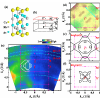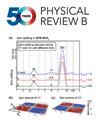Exploring possible Fermi surface nesting and the nature of heavy quasiparticles in the spin-triplet superconductor candidate CeRh2As2
IF 3.7
2区 物理与天体物理
Q1 Physics and Astronomy
引用次数: 0
Abstract
In this Letter, we investigate the electronic structure of a spin-triplet superconductor candidate using high-resolution angle-resolved photoemission spectroscopy and density functional theory calculations. Notably, possible Fermi surface nesting hints at connections to magnetic excitation or quadrupole density wave phenomena, elucidating the superconducting mechanisms. Measured band structures reveal primarily localized electrons, with minor itinerant contributions. Additionally, a transition from localized to itinerant behavior and significant hybridization anisotropy underscore the role of electrons in shaping electronic properties. These findings deepen our understanding of 's unconventional superconductivity and magnetism. Further exploration promises advances in superconductivity research.

探索自旋三重超导体候选物质 CeRh2As2 中可能的费米面嵌套和重准粒子的性质
在这封信中,我们利用高分辨率角分辨光发射光谱和密度泛函理论计算,研究了自旋三重超导体候选物质 CeRh2As2 的电子结构。值得注意的是,可能的费米面嵌套暗示了与磁激发或四极密度波现象的联系,从而阐明了超导机制。测量到的能带结构显示,4f 电子主要是局域化的,只有少量的流动电子。此外,从局部行为到巡回行为的转变以及显著的 c-f 杂化各向异性突出了 f 电子在塑造电子特性方面的作用。这些发现加深了我们对 CeRh2As2 的非传统超导性和磁性的理解。进一步的探索有望推动超导研究的发展。
本文章由计算机程序翻译,如有差异,请以英文原文为准。
求助全文
约1分钟内获得全文
求助全文
来源期刊

Physical Review B
物理-物理:凝聚态物理
CiteScore
6.70
自引率
32.40%
发文量
0
审稿时长
3.0 months
期刊介绍:
Physical Review B (PRB) is the world’s largest dedicated physics journal, publishing approximately 100 new, high-quality papers each week. The most highly cited journal in condensed matter physics, PRB provides outstanding depth and breadth of coverage, combined with unrivaled context and background for ongoing research by scientists worldwide.
PRB covers the full range of condensed matter, materials physics, and related subfields, including:
-Structure and phase transitions
-Ferroelectrics and multiferroics
-Disordered systems and alloys
-Magnetism
-Superconductivity
-Electronic structure, photonics, and metamaterials
-Semiconductors and mesoscopic systems
-Surfaces, nanoscience, and two-dimensional materials
-Topological states of matter
 求助内容:
求助内容: 应助结果提醒方式:
应助结果提醒方式:


